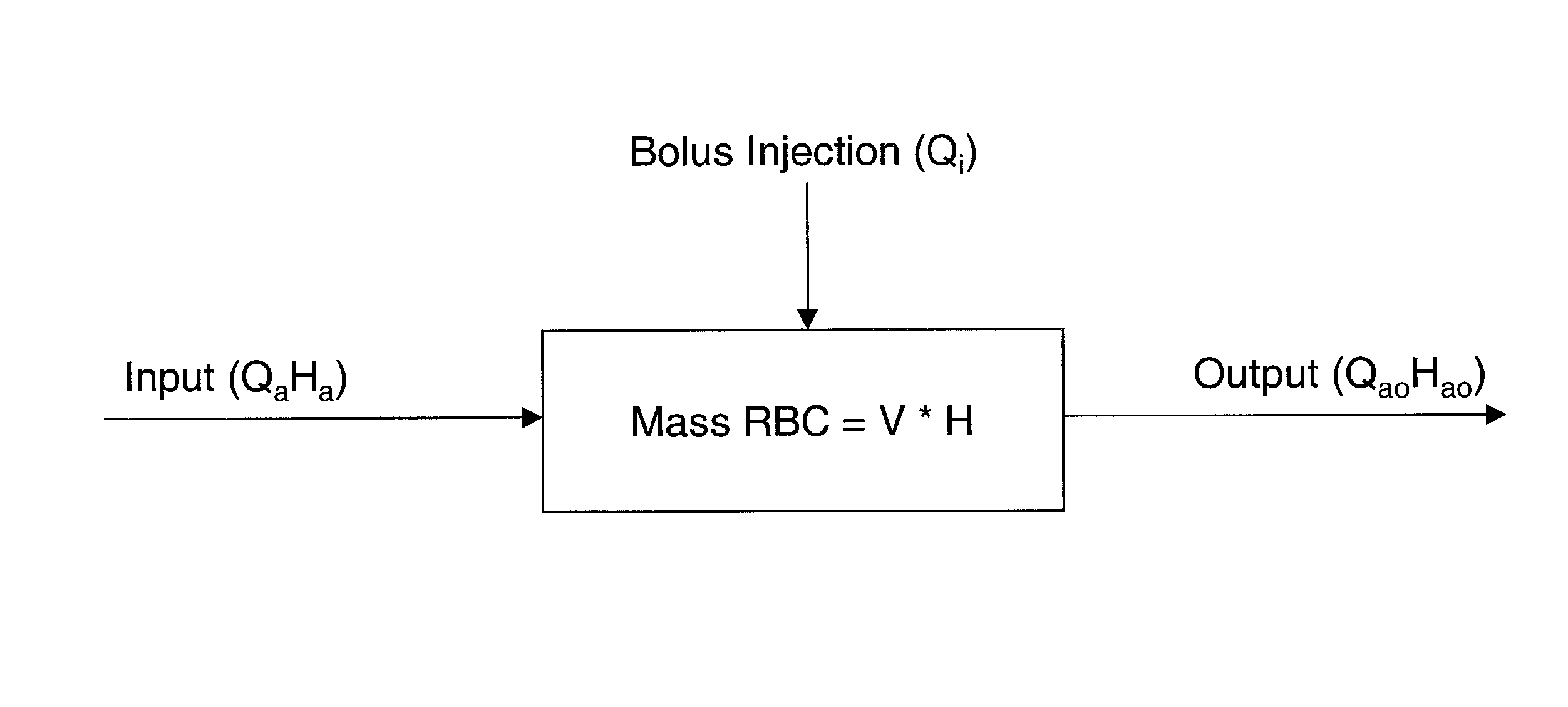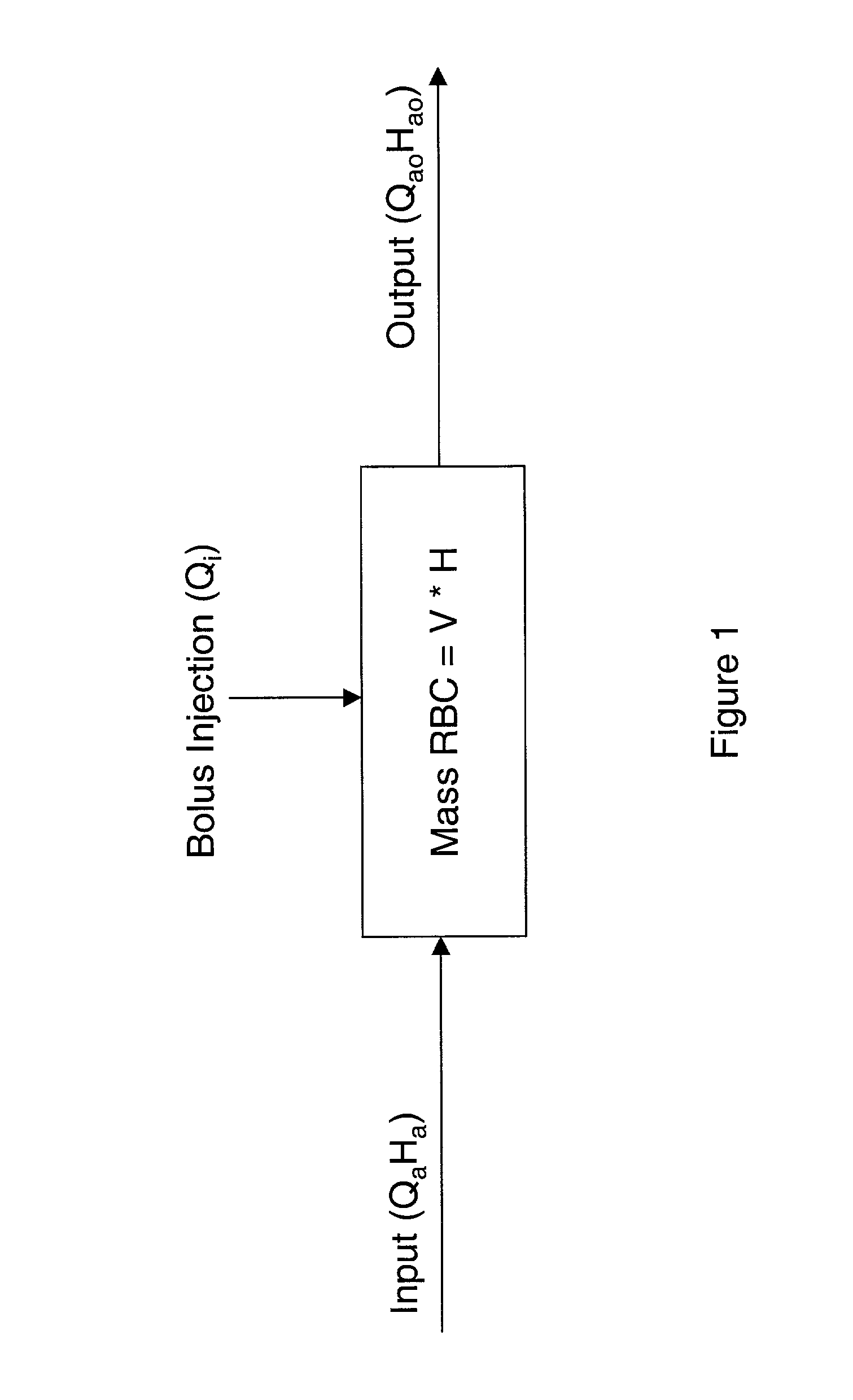Method of measuring transcutaneous access blood flow
- Summary
- Abstract
- Description
- Claims
- Application Information
AI Technical Summary
Benefits of technology
Problems solved by technology
Method used
Image
Examples
first embodiment
[0101] In the method, a stable (baseline) value H.sub.a proportional to the hematocrit in the access is first obtained. Then, a known volume (V) of a reference diluent (for example, normal saline) is injected into the dialysis venous line upstream of the venous needle. The diluent reduces the hematocrit in the vascular access site 12 beneath the sensor 10 to a time-dependent hematocrit H(t) during the injection. Using the signals produced from the time the diluent is injected to the time the signal returns to the baseline value, Q.sub.a can be calculated by the monitoring system using either the transient formulation (equation (9)) or the steady state formulation (equation (10)).
second embodiment
[0102] A method in accordance with the present invention is a method of measuring TQ.sub.a based on Q.sub.i.DELTA.T (the steady flow formulation, a transit time). The sensor may be of the type shown in FIGS. 2, 8, or 14 of the co-pending application.
[0103] The TQ.sub.a detector / emitter-set array is applied parallel to the flow and atop the access site 12 at H.sub.a0 between the venous needle site 12b and the access / vein connection 20c. The TQ.sub.a array emitters can be spaced at 8, 16, 20, and 24 mm for averaging Q.sub.a and better SNR. Saline injection is achieved via the drip bag 30c and the dialyzer pump 30b or via a syringe inserted into the arterial needle port 12a. Before dialysis begins and while the AV circuit is primed with saline, the arterial line in the hemodialysis circuit is clamped off, the saline drip bag 30c is opened, and two priming flushes of two seconds duration each are infused into the shunt flow at differing blood pump flow rates of Q.sub.i1 and Q.sub.i2, su...
third embodiment
[0110] A method in accordance with the present invention is a method of measuring TQ.sub.a in a hemodialysis circuit based on prime TQ.sub.a. In this embodiment, a hemodialysis circuit, the priming saline volume is used as a single 10 second saline bolus when Q.sub.b=300 ml / min. Preferably, the TQ.sub.a sensor is as shown in FIG. 20 of the co-pending application, is 24 mm square, and employs an outboard sensor array capable of making both parallel and perpendicular measurements. The TQ.sub.a sensor is applied over the H.sub.a0 shunt area, preferably between the venous needle site 12b and the access / vein connection 20c, as shown in FIG. 3 in connection with the sensor 10.
[0111] Prior to the priming dilution, the TQ.sub.a sensor makes a perpendicular measurement of .alpha. of normal shunt flow. The (arterial) dialyzer Q.sub.b pump 30b is then run for 10 seconds to clear the saline. As the saline enters and mixes with the shunt flow, the second TQ.sub.a sensor 10 makes perpendicular me...
PUM
 Login to View More
Login to View More Abstract
Description
Claims
Application Information
 Login to View More
Login to View More - R&D
- Intellectual Property
- Life Sciences
- Materials
- Tech Scout
- Unparalleled Data Quality
- Higher Quality Content
- 60% Fewer Hallucinations
Browse by: Latest US Patents, China's latest patents, Technical Efficacy Thesaurus, Application Domain, Technology Topic, Popular Technical Reports.
© 2025 PatSnap. All rights reserved.Legal|Privacy policy|Modern Slavery Act Transparency Statement|Sitemap|About US| Contact US: help@patsnap.com



